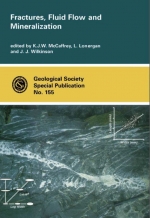Добрый день, Коллеги. Важное сообщение, просьба принять участие. Музей Ферсмана ищет помощь для реставрационных работ в помещении. Подробности по ссылке
Fractures, fluid flow and mineralization / Трещины, движение флюидов и минерализация
Prior to Hubbert and Rubey's classic paper (Hubbert & Rubey 1959), which specifically recognized the role of high fluid pressures in
lowering the shear stress required to move and emplace large thrust sheets, geologists had tended to ignore the importance of fluids in crustal deformation (Fyfe et al. 1978). Much has changed in the intervening 40 years. It is now accepted that not only do fluids enable deformation but that the converse is also true, i.e. that faulting can cause fluid migration. The growing interest in the relationship between fluid flow and deforming rock in a range of geological environments has led to knowledge on the topic becoming increasingly specialized. This is reflected by the number of major books published in the last decade spanning subject areas more traditionally considered the realm of structural geologists, metamorphic or sedimentary petrologists and hydrogeologists. Notable examples include: Fluids in Subduct ion Zones (Tarney et al. 1991); The Role of Fluids in Crustal Processes (National Research Council, US Geophysics Study Committee 1990); Geofluids (Parnell 1994), focusing on the flow of fluid in sedimentary basins; Rock Fractures and Fluid Flow (National Research Council, US Committee on Fracture Characterization and Fluid Flow 1996); and Fluid Flow and Transport in Rocks (Jamtveit & Yardley 1997) which addresses the integration of the physics and chemistry of fluid flow through crustal rocks.
Data collated from the major geoscience reference database, GeoRef, shows an exponen-tial growth in the number of papers published since 1975 that include 'faults/fracturing' and 'fluid' in their title or among their keywords (Fig. la). This growth, culminating in a publication rate in excess of 400 papers per annum, reflects the explosion in research interest in the subject area in the last 10-15 years. In the period from 1975 to the early 1980s, most of these publications, typically of the order of 40 per year, were concerned with ore deposits or mineralization (Fig 1b). This is not surprising given that many modern ideas concerning the flow of fluids in fractures stem from observations made as a result of human exploitation of mineral resources. <...>




